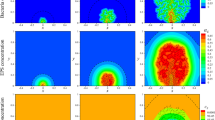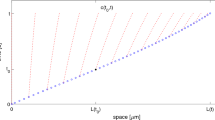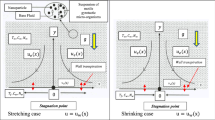Abstract
We develop a multiphasic hydrodynamic theory for biofilms taking into account interactions among various bacterial phenotypes, extracellular polymeric substance (EPS), quorum sensing (QS) molecules, solvent, and antibiotics. In the model, bacteria are classified into down-regulated QS, up-regulated QS, and non-QS cells based on their QS ability. The model is first benchmarked against an experiment yielding an excellent fit to experimental measurements on the concentration of QS molecules and the cell density during biofilm development. It is then applied to study development of heterogeneous structures in biofilms due to interactions of QS regulation, hydrodynamics, and antimicrobial treatment. Our 3D numerical simulations have confirmed that (i). QS is beneficial for biofilm development in a long run by building a robust EPS population to protect the biofilm; (ii). biofilms located upstream can induce QS downstream when the colonies are close enough spatially; (iii). QS induction may not be fully operational and can even be compromised in strong laminar flows; (v). the hydrodynamic stress alters the biofilm morphology. Through further numerical investigations, our model suggests that (i). QS-regulated EPS production contributes to the structural formation of heterogeneous biofilms; (ii) QS down-regulated cells tend to grow at the surface of the biofilm while QS up-regulated ones tend to grow in the bulk; (iii) when nutrient supply is sufficient, QS induction might be more effective upstream than downstream; (iv) QS may be of little benefit in a short timescale in term of fighting against invading strain/species; (v) the material properties of biomass (bacteria and EPS) have strong impact on the dilution of QS molecules under strong shear flow. In addition, with this modeling framework, hydrodynamic details and rheological quantities associated with biofilm formation under QS regulation can be resolved.













Similar content being viewed by others
References
Abraham W (2006) Controlling biofilms of gram-positive pathogenic bacteria. Curr Med Chem 13(13):1509–1524
Almeida A, Amado I, Reynolds J, Berges J, Lythe G, Molina-Paris C, Freitas AA (2012) Quorum sensing in cd4+ t cell homeostasis: a hypothesis and a model. Front Microbiol 3:125
Alpkvist E, Picioreanu C, van Loosdrecht M, Heyden A (2006) Three-dimensional biofilm model with individual cells and continuum eps matrix. Biotechnol Bioeng 94(5):961–979
Barbarossa MV, Kuttler C, Fekete A, Rothballer M (2010) A delay model for quorum sensing of pseudomonas putida. BioSystems 102:148–156
Bayles KW (2007) The biological role of death and lysis in biofilm development. Nat Rev Microbiol 5(9):721–726
Bell N, Garland M (2012) Cusp: generic parallel algorithms for sparse matrix and graph computations (preprint)
Cahn JW, Hilliard JE (1958) Free energy of a nonuniform system. I. Interfatial free energy. J Chem Phys 28(2):258–267
Cahn JW (1959) Free energy of a nonuniform system. II. Thermodynamic basis. J Chem Phys 30(5):1121
Cárcamo-Oyarce G, Lumjiaktase P, Kümmerli R, Eberl L (2015) Quorum sensing triggers the stochastic escape of individual cells from pseudomonas putida biofilms. Nat Commun 6:5945
Chen LQ (2002) Phase-field models for microstructure evolution. Ann Rev Mater Res 32(1):113–140
Childs H, Brugger E, Whitlock B, Meredith J, Ahern S, Pugmire D, Biagas K, Miller M, Harrison C, Weber GH, Krishnan H, Fogal T, Sanderson A, Garth C, Bethel EW, Camp D, Rübel O, Durant M, Favre JM, Navrátil P (2012) Visit: an end-user tool for visualizing and analyzing very large data. High performance visualization-enabling extreme-scale scientific. Insight, pp 357–372
Chopp DL, Kirisits MJ, Moran B, Parsek MR (2002) A mathematical model of quorum sensing in a growing bacterial biofilm. J Ind Microbiol Biotechnol 29:339–346
Chopp DL, Kirisits MJ, Moran B, Parsek MR (2003) The dependence of quorum sensing on the depth of a growing biofilm. Bull Math Biol 65:1053–1079
Choudhary S, Schmidt-Dannert C (2010) Applications of quorum sensing in biotechnology. Appl Microbiol Biotechnol 86:1267–1279
Cogan NG (2006) Effects of persister formation on bacterial response to dosing. J Theor Biol 238:694–703
Cogan NG (2011) Computational exploration of disinfection of bacterial biofilms in partially blocked channels. Int J Numer Methods Biomed Eng 27:1982–1995
Cogan NG, Keener JP (2004) The role of the biofilm matrix in structural development. Math Med Biol 21(2):147–166
Cogan NG, Keener JP (2005) Channel formation in gels. SIAM J Appl Math 65(6):1839–1854
Cogan NG, Brown J, Darres K, Petty K (2012) Optimal control strategies for disinfection of bacterial populations with persister and susceptible dynamics. Antimicrob Agents Chemother 56(9):4816–4826
Dilanji G, Langebrake J, Leenheer P, Hagen S (2012) Quorum activation at a distance: spatiotemporal patterns of gene regulation from diffusion of an autoinducer signal. J Am Chem Soc 134:5618–5626
Donlan RM (2002) Biofilms microbial life on surfaces. Emerg Infect Dis 8(9):881–890
Emerenini B, Hense B, Kuttler C, Eberl H (2015) A mathematical model of quorum sensing induced biofilm detachment. PLOS ONE 10(7):e0132385
Emerenini B, Sonner S, Eberl H (2017) Mathematical analysis of a quorum sensing induced biofilm dispersal model and numerical simulation of hollowing effects. Math Biosci Eng 14(3):625–653
Fauvart M, Phillips P, Bachaspatimayum D, Verstraeten N, Fransaer J, Michiels J, Vermant J (2012) Surface tension gradient control of bacterial swarming in colonies of pseudomonas aeruginosa. Soft Matter 8:70–76
Fekete A, Kuttler C, Rothballer M, Hense B, Fischer D, Buddrus-Schiemann K, Lucio M, Muller J, Schmitt-Kopplin P (2010) Dynamic regulation of \(n\)-acyl-homoserine lactone production and degradation in pseudomonas putidalsof. FEMS Microbiol Ecol 72:22–34
Fozard JA, Lees M, King JR, Logan BS (2012) Inhibition of quorum sensing in a computational biofilm simulation. BioSystems 109:105–114
Frederick MR, Kuttler C, Hense BA, Muller J, Eberl HJ (2010) A mathematical model of quorum sensing in patchy biofilm communities with slow background flow. Can Appl Math Q 18(3):267–298
Frederick MR, Kuttler C, Hense BA, Eberl HJ (2011) A mathematical model of quorum sensing regulated eps production in biofilm communities. Theor Biol Med Model 8(1):8
Garcia-Aljaro C, Melado-Rovira S, Milton DL, Blanch AR (2012) Quorum-sensing regulates biofilm formation in virio schophthalmi. BMC Microbiol 12:287
Guttenplan SB, Kearns DB (2013) Regulation of flagellar motility during biofilm formation. FEMS Microbiol Rev 37(6):849–871
Hammer BK, Bassler BL (2003) Quorum sensing controls biofilm formation in vibrio chelerae. Mol Microbiol 50(1):101–114
Heithoff DM, Mahan MJ (2004) Vibrio cholerae biofilms: stuck between a rock and a hard place. J Bacteriol 186(15):4835–4837
Hentzer M, Givskov M (2003) Pharmacological inhibition of quorum sensing for the treatment of chronic bacterial infections. J Clin Investig 112(9):1300–1307
Hinson R, Kocher W (1996) Model for effective diffusivities in aerobic biofilms. J Environ Eng 122(11):1023–1030
Jabbari S, King JR, Williams P (2012a) Cross-strain quorum sensing inhibition by staphylococcus aureus. Part 1: a spatially homogeneous model. Bull Math Biol 74(6):1292–3251
Jabbari S, King JR, Williams P (2012b) Cross-strain quorum sensing inhibition by staphylococcus aureus. Part 2: a spatially inhomogeneous model. Bull Math Biol 74(6):1326–1353
Keller L, Surette MG (2006) Communication in bacteria: an ecological and evolutionary perspective. Nat Rev Microbiol 4:249–258
Kim MK, Ingremeau F, Zhao A, Basseler BL, Stone HA (2016) Local and global consequences of flow on bacterial quorum sensing. Nat Microbiol 1:15005
Kirisits MJ, Margolis JJ, Purevdorj-Gage BL, Vaughan B, Chopp DL, Stoodley P, Parsek MR (2007) Influence of the hydrodynamic environment on quorum sensing in pseudomonas aeruginosa biofilms. J Bacteriol 189:8357–8360
Koerber AJ, King JR, Ward JP (2002) A mathematical model of partial-thickness burn-wound infection by pseudomonas aeruginosa: quorum sensing and the build-up to invasion. Bull Math Biol 64(239–259):239–259
Kommedal R, Bakke R, Dockery J, Stoodley P (2001) Modeling production of extracellular polymeric substances in a pseudomonas aeruginosa chemostat culture. Water Sci Technol 43(6):129–134
Langebrake J, Dilanji G, Hagen S, Leenheer P (2014) Traveling waves in response to a diffusing quorum sensing signal in spatially-extended bacterial colonies. J Theor Biol 363:53–61
Lewis K (2010) Persister cells. Ann Rev Microbiol 64(1):357–372
Lindley B, Wang Q, Zhang T (2011) A multicomponent model for biofilm-drug interaction. Discrete Contin Dyn Syst Ser B 15:417–456
Marketon MM, Glenn SA, Eberhard A, Gonzalez JE (2003) Quorum sensing controls exopolysaccharide production in sinorhizobium melioti. J Bacteriol 185(1):325–331
Matur MG, Muller J, Kuttler C, Hense RA (2015) An approximative approach for single cell spatial modeling of quorum sensing. J Comput Biol 22(3):227–235
Miller M, Bassler B (2001) Quorum sensing in bacteria. Ann Rev Microbiol 55:165–199
Nadell CD, Xavier JB, Levin SA, Foster KR (2008) The evolution of quorum sensing in bacterial biofilms. PLoS Biol 6(1):0171–0179
Nealson K, Platt T, Hastings JW (1970) The cellular control of the synthesis and activity of the bacterial luminescent system. J Bacteriol 104(1):313–322
Parsek MR, Tolker-Nielsen T (2008) Pattern formation in pseudomonas aeruginosa biofilms. Curr Opin Biotechnol 11:560–566
Perez-Velazquez J, Quinones B, Hense B, Kuttler C (2015) A mathematical model to investigate quorum sensing regulation and its heterogeneity in pseudomonas syringae on leaves. Ecol Complex 21:128–141
Picioreanu C, van Loosdrecht MCM, Heijnen JJ (1998) Mathematical modeling of biofilm structure with a hybrid differential discrete cellular automaton approach. Biotechnol Bioeng 58(1):101–116
Popat R, Crusz S, Messina M, Williams P, West S, Diggle SP (2012) Quorum-sensing and cheating in bacterial biofilms. Proc R Soc B Biol Sci 279(1748):4765–4771
Quinones B, Pujol CJ, Lindow SE (2004) Regulation of ahl production and its contribution to epiphytic fitness in pseudomonas syringae. MPMI 17(5):521–531
Quinones B, Dulla G, Lindow SE (2005) Quorum sensing regulates exopolysaccharide production, motility, and virulence in pseudomonas syringae. Mol Plant Microbe Interact 18(7):682–693
Roberts ME, Stewart PS (2005) Modeling protection from antimicrobial agents in biofilms through the formation of persister cells. Microbiology 151:75–80
Sakuragi Y, Kolter R (2007) Quorum-sensing regulation of the biofilm matrix genes (pel) of pseudomonas aeruginosa. J Bacteriol 189(14):5383–5386
Sanclement JA, Webster P, Thomas J, Ramadan HH (2005) Bacterial biofilms in surgical specimens of patients with crhonic rhinosinusitis. Laryngoscope 115(4):578–582
Shen Y, Stojic S, Haapasalo M (2011) Antimicrobial efficacy of chlorhexidine against bacteria in biofilms at different stages of development. J Endod 37(5):657–661
Shen Y, Zhao J, de la Fuente-Núñez C, Wang Z, Hancock RE, Roberts CR, Ma J, Li J, Haapasalo M, Wang Q (2016) Experimental and theoretical investigation of multispecies oral biofilm resistance to chlorhexidine treatment. Sci Rep 6:27537. doi:10.1038/srep27537
Solano C, Echeverz M, Lasa I (2014) Biofilm dispersion and quorum sensing. Curr Opin Microbiol 18:96–104
Sonner S, Efendiev MA, Eberl HJ (2011) On the well-posedness of a mathematical model of quorum-sensing in patchy biofilm communities. Math Methods Appl Sci 34:1667–1684
Stewart PS (1996) Theoretical aspects of antibiotic diffusion into microbial biofilms. Antimicrob Agents Chemother 40(11):2517–2522
Stewart PS (2003) Diffusion in biofilms. J Bacteriol 185(5):1485–1491
Teodosio JS, Simões M, Melo LF, Mergulhao FJ (2011) Flow cell hydrodynamics and their effects on E. coli biofilm formation under different nutrient conditions and turbulent flow. Biofouling 27(1):1–11
Thompson JA, Oliveira RA, Djukovic A, Ubeda C, Xavier KB (2015) Manipulation of the quorum sensing signal ai-2 affects the antibiotic-treated gut microbiota. Cell Rep 10:1–11
Uecke H, Müller J, Hense B (2014) Individual-based model for quorum sensing with background flow. Bull Math Biol 76(7):1727–1746
Vaughan B, Smith B, Chopp D (2010) The influence of fluid flow on modeling quorum sensing in bacterial biofilms. Bull Math Biol 72(5):1143–1165
Vuong C, Gerke C, Somerville G, Fischer E, Otto M (2003) Quorum-sensing control of biofilm factors in staphylococcus epidermidis. J Infect Dis 188(5):706–718
Ward JP, King JR, Koerber A, Williams P, Croft J, Sockett R (2001) Mathematical modelling of quorum sensing in bacteria. Math Med Biol 18(3):263–292
Waters CM, Basseler BL (2005) Quorum sensing: cell-to-cell communication in bacteria. Ann Rev Cell Dev Biol 21(1):319–346
Whitehead NA, Barnard A, Slater H, Simpson N, Salmond G (2001) Quorum sensing in gram-negative bacteria. FEMS Microbiol Rev 25:365–404
Xavier JB, Foster KR (2007) Cooperation and conflict in microbial biofilms. PNAS 104(3):876–881
Zhang T, Cogan NG, Wang Q (2008a) Phase-field models for biofilms i. Theory and simulations. SIAM J Appl Math 69:641–669
Zhang T, Cogan NG, Wang Q (2008b) Phase-field models for biofilms ii. 2-d numerical simulations of biofilm-flow interaction. Commun Comput Phys 4(1):72–101
Zhao J, Seeluangsawat P, Wang Q (2016a) Modeling antimicrobial tolerance and treatment of heterogeneous biofilms. Math Biosci 282:1–15
Zhao J, Shen Y, Happasalo M, Wang ZJ, Wang Q (2016b) A 3d numerical study of antimicrobial persistence in heterogeneous multi-species biofilms. J Theor Biol 392:83–98
Zhao J, Wang Q, Yang X (2016c) Numerical approximations to a new phase field model for two phase flows of complex fluids. Comput Methods Appl Mech Eng 310:77–97
Zhao J, Yang X, Shen J, Wang Q (2016d) A decoupled energy stable scheme for a hydrodynamic phase field model of mixtures of nematic liquid crystals and viscous fluids. J Comput Phys 305:539–556
Zhao J, Yang X, Wang Q (2016e) Energy stable numerical schemes for a hydrodynamic model of nematic liquid crystals. SIAM J Sci Comput 38(5):3264–3290
Zhao J, Li H, Wang Q, Yang X (2017) Decoupled energy stable schemes for a phase field model of three-phase incompressible viscous fluid flow. J Sci Comput 70(3):1367–1389
Acknowledgements
Qi Wang is partially supported by NIH and NSF through awards DMS-1200487, DMS-1517347, R01GM078994-05A1, and NSFC awards 11571032 and 91630207. Jia Zhao is partially supported by an ASPIRE grant from the Office of the Vice President for Research at the University of South Carolina.
Author information
Authors and Affiliations
Corresponding author
Rights and permissions
About this article
Cite this article
Zhao, J., Wang, Q. Three-Dimensional Numerical Simulations of Biofilm Dynamics with Quorum Sensing in a Flow Cell. Bull Math Biol 79, 884–919 (2017). https://doi.org/10.1007/s11538-017-0259-4
Received:
Accepted:
Published:
Issue Date:
DOI: https://doi.org/10.1007/s11538-017-0259-4




